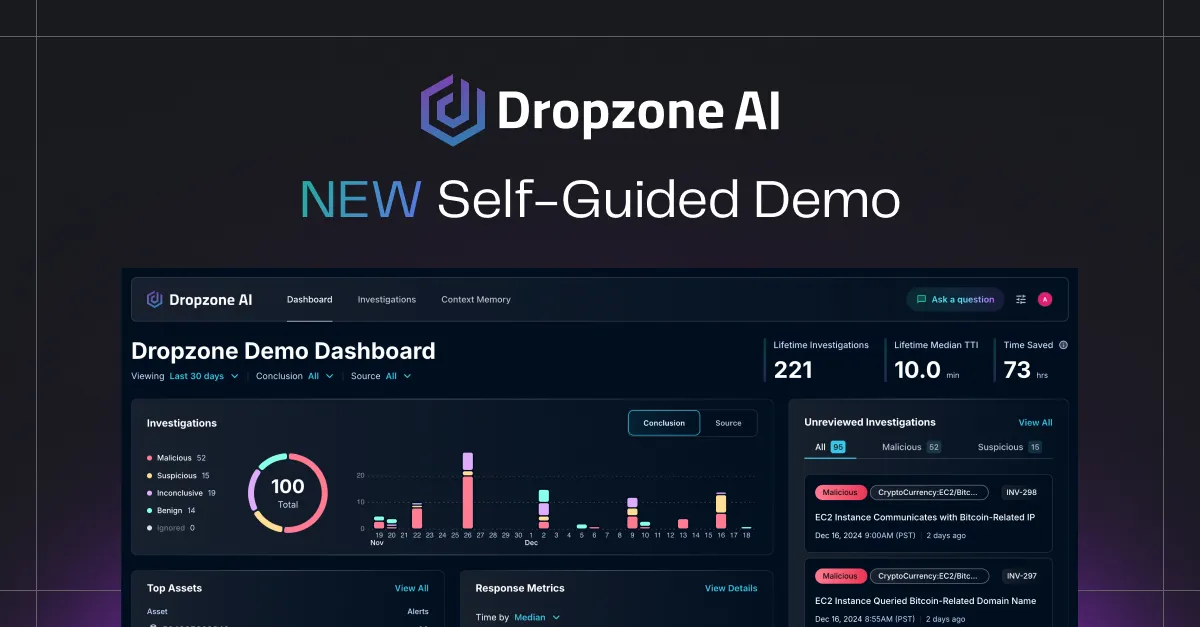The Knowledge Gap That Makes Security Operations Inefficient
Consider two SOC analysts investigating the same alert about unusual VPN access from a new location. The veteran analyst, with three years at your organization, immediately recognizes it as the CFO's quarterly travel pattern to the Singapore office. The new analyst, equally skilled but unfamiliar with your environment, escalates it as potential credential compromise. Both analysts are technically competent, yet their effectiveness differs dramatically based on one critical factor: institutional knowledge.
This knowledge gap represents a fundamental challenge in security operations. According to IBM's 2025 Cost of a Data Breach Report, 97% of organizations experiencing AI-related breaches lacked proper access controls, while security incidents involving shadow AI added $670,000 to average breach costs. The root cause often traces back to security systems that cannot distinguish between legitimate and malicious activity within specific organizational contexts.
Context Memory addresses this challenge by enabling AI security systems to build and apply organization-specific knowledge, transforming how autonomous SOC analysts understand and investigate alerts in your unique environment.
What is Context Memory in AI Security?
Context Memory is an AI security capability that enables autonomous systems to learn and remember organization-specific patterns, behaviors, and environmental details. Unlike static rules or basic machine learning baselines, Context Memory allows AI SOC analysts to distinguish between normal and anomalous activities based on accumulated knowledge of your unique environment, similar to how experienced human analysts develop institutional expertise over time.
In technical terms, Context Memory functions as a specialized knowledge management system within AI security platforms. It captures, stores, and applies environmental context during security investigations, enabling AI systems to make nuanced decisions that reflect the specific realities of your organization rather than generic security assumptions.
The concept extends beyond simple pattern matching or statistical anomaly detection. Context Memory creates a dynamic, evolving understanding of your environment that improves investigation accuracy while reducing the false positives that plague traditional security tools. This capability becomes particularly critical as organizations adopt AI-powered security solutions that must operate with the same contextual awareness as experienced human analysts.
How Context Memory Works: The Three-Stage Process
Context Memory operates through a sophisticated three-stage process that mirrors how expert analysts develop and apply institutional knowledge. Based on Dropzone AI's implementation, this process enables continuous learning and improvement in security operations.
Stage 1: Collect - Building Organizational Intelligence
The collection phase establishes the foundation of organizational knowledge through multiple channels:
Automated Discovery: During initial deployment and ongoing operations, Context Memory automatically identifies and catalogues:
- Network topology and architecture patterns
- User roles and typical access patterns
- System configurations and dependencies
- Integration points between security tools
- Business-critical applications and services
Investigation Learning: Each security investigation contributes to the knowledge base. When an AI SOC analyst investigates an alert and determines it represents legitimate activity, Context Memory stores relevant details about:
- The specific conditions that triggered the alert
- Environmental factors that confirmed legitimacy
- User and system behaviors involved
- Time-based patterns (maintenance windows, business cycles)
Human Feedback Integration: Security analysts enhance Context Memory by:
- Correcting investigation conclusions with explanatory feedback
- Adding specific environmental details directly
- Identifying approved tools and services
- Documenting exception cases and business justifications
Stage 2: Comprehend - Organizing and Recalling Knowledge
Context Memory employs vector database architecture to organize information for rapid, contextually relevant retrieval:
Intelligent Organization: Information is structured to enable:
- Relationship mapping between entities (users, devices, applications)
- Temporal pattern recognition (time-of-day, day-of-week, monthly cycles)
- Behavioral baseline establishment for different user groups
- Exception tracking for approved deviations
Dynamic Retrieval: During investigations, the system:
- Identifies relevant historical context
- Correlates current activity with stored patterns
- Retrieves applicable organizational policies
- Accesses previous investigation outcomes for similar scenarios
Stage 3: Conclude - Applying Context for Accurate Decisions
The application phase transforms stored knowledge into improved investigation outcomes:
Contextual Analysis: Every alert investigation incorporates:
- Historical precedents from similar alerts
- Organization-specific risk factors
- Business context for observed activities
- Environmental factors unique to your infrastructure
Accuracy Enhancement: According to Dropzone AI's deployment data, Context Memory enables:
- 75-95% reduction in Mean Time to Conclusion (MTTC)
- Investigation completion in 3-11 minutes versus 20-40 minutes manually
- Consistent investigation quality across all alerts
- Reduced false positive rates through environmental awareness
Types of Context Stored and Applied
Context Memory maintains four distinct categories of organizational knowledge, each contributing to more accurate security investigations:
1. Environmental Context
Environmental context encompasses the technical landscape of your organization:
- Infrastructure Mapping: Documented relationships between servers, applications, and services
- Network Patterns: Typical traffic flows, communication patterns, and data movement
- Tool Configuration: Security tool settings, integration points, and data flows
- Cloud Resources: Cloud service usage patterns, API connections, and SaaS application behaviors
Example Application: When investigating unusual AWS API calls, Context Memory recognizes scheduled terraform deployments by the DevOps team, preventing false positive escalation.
2. Behavioral Context
Behavioral patterns form the baseline for detecting genuine anomalies:
- User Activity Profiles: Individual and role-based behavior patterns
- Access Patterns: Typical resource access times and methods
- Authentication Behaviors: Normal login patterns, including locations and devices
- Communication Patterns: Email, collaboration tool usage, and data sharing behaviors
Example Application: Context Memory learns that the finance team regularly accesses sensitive databases during month-end closing, distinguishing this from potential data exfiltration.
3. Historical Context
Past investigations and incidents inform future decision-making:
- Previous Investigations: Outcomes and patterns from similar alerts
- Incident Patterns: Common attack vectors specific to your organization
- False Positive History: Recurring benign activities that trigger alerts
- Response Effectiveness: Success rates of different containment strategies
Example Application: Based on previous investigations, Context Memory recognizes that alerts from a specific legacy application are consistently benign, allowing faster triage.
4. Organizational Context
Business-specific knowledge that security tools typically lack:
- Business Processes: Critical workflows and their security implications
- Organizational Structure: Reporting relationships and approval chains
- Compliance Requirements: Industry-specific regulations and controls
- Risk Tolerance: Acceptable risk levels for different business functions
Example Application: Context Memory understands that marketing team members legitimately use consumer VPN services for competitive research, while such usage from IT staff warrants investigation.
Context Memory vs. Traditional Approaches: A Detailed Comparison
Understanding how Context Memory differs from traditional security approaches clarifies its value in modern SOC operations:
Why Static Rules Fail
Traditional SOAR platforms rely on predetermined playbooks that cannot account for organizational nuances. According to the SANS 2025 SOC Survey, 69% of SOCs still rely on manual processes, partly because static automation cannot handle the complexity of real-world environments. A rule blocking VPN access from new locations would generate false positives for traveling employees, while Context Memory learns legitimate travel patterns.
Limitations of Basic ML Baselines
Machine learning baselines improve upon static rules by identifying statistical anomalies, but they lack organizational context. They might flag unusual database access as suspicious without understanding that quarterly audits require such access. Context Memory bridges this gap by combining statistical analysis with environmental understanding.
Measurable Benefits and ROI of Context Memory
Organizations implementing Context Memory experience quantifiable improvements across multiple metrics:
False Positive Reduction
Context Memory dramatically reduces alert noise by understanding legitimate activities:
- Contractor Access Recognition: Learns approved third-party access patterns, eliminating weekly false positives from contractor VPNs
- Maintenance Window Awareness: Recognizes scheduled system maintenance, preventing overnight alert storms
- Development Tool Understanding: Distinguishes between legitimate admin tools and potential attack tools based on user context
Real-World Impact: A financial services organization reduced false positives from 400 daily to 120, freeing 15 hours of analyst time per week.
Investigation Acceleration
By applying accumulated knowledge, Context Memory accelerates every investigation phase:
- Instant Context Retrieval: No manual searching through documentation or previous tickets
- Automated Correlation: Immediate connection of related events and patterns
- Precedent Application: Previous investigation outcomes inform current decisions
Measured Results: Average investigation time drops from 20-40 minutes to 3-11 minutes, enabling teams to handle 5-10x more alerts without adding staff.
Coverage Expansion: 100% Alert Investigation
Unlike human teams that must prioritize high-severity alerts, Context Memory enables consistent investigation of all alerts:
- Low-Priority Alert Coverage: Catches sophisticated attacks hiding in routine alerts
- Consistent Quality: Every alert receives thorough investigation regardless of timing or volume
- Hidden Threat Detection: Identifies subtle patterns across multiple low-severity events
Best Practices for Maximizing Context Memory Value
Since Context Memory is a built-in capability of Dropzone AI's SOC analyst, SOC teams benefit most by understanding how to optimize its learning and application within their environment:
Understanding the Learning Curve (First 30 Days)
While Dropzone AI's SOC analyst begins investigating alerts immediately with pre-trained security knowledge, Context Memory continuously builds organization-specific understanding:
Week 1-2: Environmental Discovery
- The AI SOC analyst maps your infrastructure relationships through investigations
- Learns user roles and typical access patterns from observed activities
- Identifies normal communication flows between systems
Week 3-4: Pattern Recognition
- Establishes behavioral baselines for different user groups
- Recognizes recurring legitimate activities that trigger alerts
- Understands business cycles and time-based patterns
Ongoing: Continuous Adaptation
- Refines understanding through each investigation
- Incorporates analyst feedback to improve accuracy
- Automatically adapts to environmental changes
Accelerating Context Memory Learning
Provide Detailed Feedback: When analysts correct investigation conclusions, explaining the reasoning helps Context Memory understand the nuance. For example, noting that "This VPN access is legitimate because it's from our Singapore office during their business hours" teaches geographic and temporal patterns.
Add Environmental Details Proactively: Rather than waiting for Context Memory to learn through investigations, security teams can directly add information about:
- Approved VPN services and IP ranges
- Scheduled maintenance windows
- Known contractor access patterns
- Business-critical processes that may trigger alerts
Review and Validate Stored Context: Periodically check what Context Memory has learned about your environment to ensure accuracy, especially after:
- Major infrastructure changes
- Organizational restructuring
- New tool deployments
- Changes in business processes
Maintain Context Relevance: Remove outdated patterns when systems are decommissioned or when employees leave, ensuring Context Memory's knowledge remains current and accurate.
Working with Context Memory
Since Context Memory operates as an integrated part of the AI SOC analyst, security teams interact with it through:
- Investigation Feedback: Correcting conclusions helps refine understanding
- Direct Context Updates: Adding or modifying stored environmental knowledge
- Context Review Interface: Viewing what the system has learned
- Investigation Reports: Seeing how Context Memory influenced decisions
The Future of Context Memory in Security Operations
As AI-powered security evolves, Context Memory capabilities will expand to address emerging challenges. Advanced correlation across disparate systems will enable detection of sophisticated multi-stage attacks. Predictive capabilities will anticipate potential security issues based on historical patterns and environmental changes.
The technology also presents opportunities for controlled knowledge sharing, where organizations could benefit from anonymized pattern intelligence while maintaining complete data privacy. This collaborative approach could accelerate threat detection across industries while preserving the organization-specific context that makes Context Memory effective.
Conclusion
Context Memory represents a fundamental advancement in how AI security systems understand and protect organizations. By building and applying organization-specific knowledge, it bridges the gap between generic security tools and the nuanced understanding that effective security requires.
For security teams evaluating AI-powered solutions, Context Memory offers measurable benefits: 70% false positive reduction, 75-95% faster investigations, and comprehensive alert coverage without additional headcount. More importantly, it provides what static rules and basic ML cannot: an AI security system that truly understands your environment.
As organizations face increasing alert volumes and sophisticated threats, Context Memory transforms from an advanced capability to essential security infrastructure. It enables AI SOC analysts to operate with the contextual awareness of experienced human analysts while maintaining the speed, consistency, and scale that only automation can provide.









